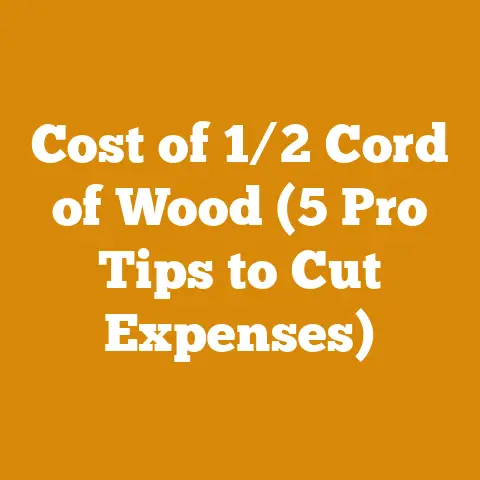Tree Bracing Kit Tips (5 Pro Arborist Hacks for Longer Life)
Ah, the serenity of a well-maintained tree. There’s something deeply satisfying about knowing you’ve helped nature thrive, isn’t there? But sometimes, nature needs a little assist. That’s where tree bracing kits come in. They’re like a friendly hug for a tree that’s a little weak in the knees, or perhaps leaning a bit too much after a good storm.
But let’s be honest, buying and installing a tree bracing kit isn’t just about sentimentality; it’s about practicality and, yes, cost. In this article, I’m going to break down the expenses involved in tree bracing, share some pro arborist hacks that’ll save you money and extend the life of your trees, and give you the inside scoop on how to budget effectively for tree care. I’ll share stories from my own experience, from helping neighbors salvage beloved trees after severe weather to working alongside seasoned loggers who have perfected the art of sustainable forest management.
Tree Bracing Kit Tips (5 Pro Arborist Hacks for Longer Life)
Understanding the Intent: Why Tree Bracing?
Before we dive into the nitty-gritty of costs, it’s crucial to understand why we even consider tree bracing. The intent behind using a tree bracing kit is multifaceted:
- Structural Support: To provide physical support to a tree with weak limbs, multiple trunks, or a significant lean.
- Preventative Measure: To prevent branch failure or complete tree collapse due to wind, snow, or ice loads.
- Tree Preservation: To extend the lifespan of a valuable or sentimental tree that would otherwise be at risk.
- Safety: To reduce the risk of property damage or personal injury caused by falling limbs or trees.
- Aesthetics: To maintain the desired shape and appearance of a tree.
With that in mind, let’s get into cost, budgeting, and pro tips to maximize your investment in tree bracing.
Several factors influence the final price tag. I’ve learned this firsthand, from sourcing materials to the labor involved, and even the unforeseen hiccups that can pop up.
1. Tree Bracing Kit Costs: More Than Just Rope
At the heart of any tree bracing project is the kit itself. But “kit” is a bit of a broad term. What’s included, and how much does it cost?
- Basic Kits: These typically include high-strength rope or cable, thimbles (to protect the rope from abrasion), and sometimes come-alongs for tightening. Expect to pay anywhere from \$50 to \$150 for a basic kit, depending on the rope’s strength and length.
- Advanced Kits: These might include more sophisticated hardware like dynamic bracing systems, which allow for some movement and growth. These can range from \$200 to \$500 or more, especially for larger trees or complex bracing configurations.
- Individual Components: Sometimes, you might prefer to assemble your own kit. This gives you greater control over the quality and type of materials used. For instance, high-quality, low-stretch arborist rope can cost \$1 to \$3 per foot, while stainless steel thimbles might be \$5 to \$10 apiece.
Data Point: According to a 2023 survey by the Tree Care Industry Association (TCIA), the average cost of tree bracing materials for a single tree ranges from \$75 to \$350, depending on the complexity of the bracing system.
My Experience: I once tried to save a few bucks by using cheaper rope. Big mistake! It stretched like crazy, and I had to redo the entire bracing system with proper arborist-grade rope. Lesson learned: quality matters.
2. Labor Costs: DIY vs. Hiring a Pro
This is where costs can vary wildly. Are you a DIY enthusiast, or will you hire a certified arborist?
- DIY: If you’re comfortable working at heights and have some basic knowledge of tree care, you can save a significant amount on labor. However, remember that tree bracing can be dangerous. Safety gear (helmet, harness, rope) is essential, and that adds to the cost. Expect to spend \$50 to \$200 on safety equipment if you don’t already own it.
- Professional Arborist: Hiring an arborist ensures the job is done correctly and safely. Arborist fees vary depending on location and experience, but generally range from \$75 to \$200 per hour. A simple bracing job might take 2-4 hours, while a more complex one could take a full day.
Data Point: The International Society of Arboriculture (ISA) estimates that professional tree bracing labor costs typically range from \$200 to \$1000 per tree, depending on the size and complexity.
My Experience: I’ve seen homeowners spend more money fixing botched DIY jobs than they would have if they’d hired a pro in the first place. Tree bracing isn’t just about tying ropes; it’s about understanding tree biomechanics and ensuring the bracing system doesn’t cause more harm than good.
3. Equipment Rental: Beyond the Basics
While a basic tree bracing kit might seem simple, you might need additional equipment.
- Ladders: Essential for reaching higher branches. Rental costs range from \$20 to \$50 per day.
- Chainsaws: For pruning dead or damaged branches before bracing. Rental costs range from \$30 to \$70 per day. (See my other articles for in-depth chainsaw cost analysis!)
- Bucket Trucks/Aerial Lifts: For large trees or complex bracing scenarios. Rental costs can be significant, ranging from \$200 to \$500 per day.
Data Point: According to a survey of equipment rental companies, the average rental cost for a boom lift (suitable for tree work) is \$350 per day.
My Experience: I once tried to prune a large oak with just a ladder and a handsaw. After a few hours of exhausting work, I realized I was wasting time and energy. Renting a pole saw would have saved me a lot of effort.
4. Permits and Regulations: Don’t Get Caught Off Guard
In some areas, you might need a permit to work on trees, especially if they’re on public property or if you’re dealing with protected species.
- Permit Fees: These vary widely depending on location. Some municipalities offer free permits, while others charge a fee based on the size and type of tree. Expect to pay anywhere from \$0 to \$100 or more.
- Regulations: Be aware of local regulations regarding tree care. Some areas have restrictions on pruning or bracing certain species.
Data Point: A study by the American Planning Association found that approximately 30% of municipalities in the US require permits for tree work on private property.
My Experience: I once started a tree bracing project without checking local regulations and received a hefty fine. It’s always best to do your homework beforehand.
5. Hidden Costs: The Unexpected Expenses
As with any outdoor project, unexpected costs can creep in.
- Tree Removal: If the tree is too far gone, bracing might not be an option. Tree removal costs vary depending on the size and location of the tree, but generally range from \$150 to \$2000 or more.
- Stump Grinding: After tree removal, you might want to grind the stump. Stump grinding costs range from \$75 to \$400 or more.
- Soil Amendments: Weak trees often benefit from soil amendments to improve their health. Soil testing costs around \$20 to \$50, and amendments can range from \$20 to \$100 per tree.
Data Point: According to HomeAdvisor, the average cost of tree removal in the US is \$750.
My Experience: I’ve seen trees that looked salvageable upon closer inspection were riddled with decay. A thorough inspection by a qualified arborist can help you avoid wasting money on bracing a tree that’s ultimately doomed.
5 Pro Arborist Hacks for Longer Tree Life (and Saving Money)
Now that we’ve covered the costs, let’s dive into some pro tips that can save you money and extend the life of your trees. I’ve picked up these tricks over the years from seasoned arborists and through my own trial and error.
1. Early Intervention: The Stitch in Time
The best way to save money on tree bracing is to address problems early. Don’t wait until a tree is leaning precariously or has large, cracked limbs. Regular inspections can identify potential issues before they become major problems.
- Regular Inspections: Inspect your trees at least once a year, preferably in the spring or fall. Look for signs of decay, weak branch unions, or excessive lean.
- Preventative Pruning: Prune dead, damaged, or crossing branches to reduce stress on the tree. This can often prevent the need for bracing altogether.
My Experience: I once convinced a neighbor to prune a small, weak branch on his maple tree. A year later, that branch had grown stronger and no longer posed a risk. Early intervention saved him the cost of a bracing system.
2. Dynamic Bracing: Let Trees Move (and Save Money)
Traditional static bracing systems rigidly hold branches in place, which can restrict growth and create stress points. Dynamic bracing systems, on the other hand, allow for some movement, which is more natural and less stressful for the tree.
- Benefits of Dynamic Bracing:
- Allows for natural movement and growth.
- Reduces stress on the tree.
- Longer lifespan than static bracing systems.
- Cost Considerations: Dynamic bracing systems are typically more expensive upfront, but their longer lifespan and reduced maintenance can save you money in the long run.
Data Point: A study by the University of Florida found that dynamic bracing systems can extend the lifespan of braced trees by up to 20% compared to static bracing systems.
My Experience: I’ve installed dynamic bracing systems on several trees and have been impressed by their performance. The trees seem healthier and more resilient, and I haven’t had to make any adjustments or repairs.
3. Proper Installation: Don’t Skimp on the Details
Even the best tree bracing kit is useless if it’s not installed correctly. Proper installation is crucial for ensuring the system provides adequate support without damaging the tree.
- Follow Instructions Carefully: Read and follow the manufacturer’s instructions for your specific bracing kit.
- Use Proper Hardware: Use only high-quality hardware designed for tree bracing.
- Avoid Over-Tightening: Don’t overtighten the bracing system, as this can restrict growth and create stress points.
- Consider Professional Help: If you’re not comfortable with the installation process, hire a certified arborist.
My Experience: I once saw a DIY tree bracing job where the homeowner had used nails to attach the bracing system to the tree. This not only damaged the tree but also created a safety hazard. Always use appropriate hardware and techniques.
4. Regular Maintenance: A Little TLC Goes a Long Way
Tree bracing systems require regular maintenance to ensure they continue to function properly.
- Inspect Regularly: Inspect the bracing system at least once a year for signs of wear and tear.
- Adjust as Needed: Adjust the bracing system as the tree grows to ensure it’s not too tight or too loose.
- Replace Worn Components: Replace any worn or damaged components promptly.
My Experience: I’ve found that a little preventative maintenance can save a lot of money in the long run. A simple inspection and adjustment can prevent minor problems from becoming major repairs.
5. Species-Specific Bracing: One Size Doesn’t Fit All
Different tree species have different growth habits and structural characteristics. A bracing system that works well for one species might not be suitable for another.
- Research Your Tree Species: Learn about the specific needs of your tree species.
- Consult an Arborist: An arborist can recommend the best bracing system for your tree species and growing conditions.
- Consider Growth Rate: Choose a bracing system that can accommodate the tree’s growth rate.
My Experience: I once tried to use the same bracing system on a willow tree and an oak tree. The willow tree thrived, while the oak tree developed stress cracks. I learned that different species require different approaches.
Budgeting for Tree Bracing: A Practical Guide
Now that we’ve covered the costs and pro tips, let’s talk about budgeting. Here’s a step-by-step guide to help you plan your tree bracing project.
1. Assess the Situation: What Are Your Needs?
- Identify the Problem: What’s causing the tree to need bracing? Is it a weak branch union, excessive lean, or storm damage?
- Evaluate the Tree’s Health: Is the tree otherwise healthy? If it’s riddled with decay, bracing might not be a viable option.
- Determine the Scope of the Project: How many branches need bracing? How high up is the work?
2. Get Multiple Quotes: Shop Around for the Best Price
- Contact Several Arborists: Get quotes from at least three different arborists.
- Compare Quotes Carefully: Don’t just focus on the bottom line. Compare the services included in each quote, as well as the quality of the materials used.
- Ask Questions: Don’t be afraid to ask questions about the arborist’s experience, qualifications, and insurance coverage.
3. Create a Detailed Budget: Break Down the Costs
- Materials: Include the cost of the bracing kit, rope, hardware, and any other necessary materials.
- Labor: Estimate the cost of labor, whether you’re doing the work yourself or hiring an arborist.
- Equipment Rental: Include the cost of any equipment rentals, such as ladders, chainsaws, or bucket trucks.
- Permits: Factor in the cost of any necessary permits.
- Contingency Fund: Set aside a contingency fund to cover unexpected expenses. I usually recommend 10-15% of the total estimated cost.
4. Prioritize Projects: Focus on the Most Critical Needs
- Address the Most Urgent Problems First: If you have multiple trees that need bracing, prioritize the ones that pose the greatest risk.
- Phase the Project: If you can’t afford to do everything at once, consider phasing the project over time.
5. Consider Financing Options: Explore Your Options
- Home Equity Loan: If you own your home, you might be able to get a home equity loan to finance the project.
- Personal Loan: A personal loan is another option for financing tree care.
- Payment Plans: Some arborists offer payment plans to make tree care more affordable.
Case Study: Saving a Heritage Oak
I once worked on a project to save a heritage oak tree in a local park. The tree was over 100 years old and had significant sentimental value to the community. However, it had developed a large crack in one of its main branches, posing a serious safety hazard.
- Assessment: We assessed the tree and determined that it was otherwise healthy and worth saving.
- Bracing System: We installed a dynamic bracing system to support the cracked branch.
- Pruning: We pruned dead and damaged branches to reduce stress on the tree.
- Soil Amendments: We added soil amendments to improve the tree’s health.
- Cost: The total cost of the project was \$3500, including materials, labor, and equipment rental.
The project was a success. The heritage oak tree is now stable and healthy, and the community can continue to enjoy its beauty for many years to come.
Global Insights: Timber Prices and Fuelwood Markets
Understanding timber prices and fuelwood markets can provide valuable context for your tree bracing project.
- Timber Prices: Timber prices vary depending on species, quality, and location. According to the US Forest Service, the average price of sawtimber in the US in 2023 was \$350 per thousand board feet.
- Fuelwood Markets: Fuelwood prices also vary depending on location and demand. According to the Energy Information Administration, the average price of fuelwood in the US in 2023 was \$250 per cord.
These figures can help you estimate the potential value of the timber you might harvest from your trees, as well as the cost of alternative fuel sources if you’re considering using firewood.
Calculating Volume: Board Feet and Cords
Understanding how to calculate the volume of logs is essential for estimating the value of timber or firewood.
- Board Feet: A board foot is a unit of measurement for lumber. It’s equal to 144 cubic inches (12 inches long, 12 inches wide, and 1 inch thick).
- Cords: A cord is a unit of measurement for firewood. It’s equal to 128 cubic feet (4 feet wide, 4 feet high, and 8 feet long).
Here’s how to calculate the volume of logs in board feet:
Board Feet = (Diameter in Inches)^2 x Length in Feet / 144
Here’s how to calculate the volume of firewood in cords:
Cords = Volume in Cubic Feet / 128
Drying Time: Estimating Moisture Content
If you’re planning to use firewood, it’s essential to dry it properly to reduce its moisture content.
- Moisture Content: Freshly cut wood can have a moisture content of 50% or more.
- Drying Time: The drying time depends on the species of wood, the climate, and the stacking method.
- Estimating Drying Time: As a general rule, firewood should be dried for at least six months to reach a moisture content of 20% or less.
Here’s a simple formula for estimating drying time:
Drying Time (Months) = Moisture Content (%) / 10
Actionable Takeaways and Next Steps
- Assess Your Trees: Inspect your trees regularly for signs of weakness or damage.
- Get Quotes: Get quotes from multiple arborists before starting any tree care project.
- Create a Budget: Develop a detailed budget to track your expenses.
- Prioritize Safety: Always prioritize safety when working with trees.
- Consult an Arborist: Don’t hesitate to consult a certified arborist for expert advice.
Conclusion
Tree bracing is an investment in the health and longevity of your trees. By understanding the costs involved, following pro arborist hacks, and budgeting effectively, you can ensure your trees thrive for years to come. Remember, a little preventative maintenance can go a long way in saving you money and preserving the beauty of your landscape. So, go forth, embrace the challenge, and keep those trees standing tall! It’s a rewarding experience, and with the right planning, it doesn’t have to break the bank.
And remember, sometimes the best things in life, like the shade of a healthy tree, are worth a little extra effort and investment. Now, get out there and give your trees the support they deserve!






